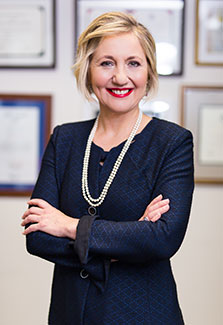Preventing mother-to-child HIV transmission in South Africa: Q and A with Dr Glenda Gray
November / December 2018 | Volume 17, Number 6

Photo courtesy of Dr. Glenda Gray
Glenda Gray, MBBCH, FCPaed (SA),
DSc (honoris causa)
Dr. Glenda Gray became a pediatrician in the 1990s as HIV/AIDS was gathering steam and her native South Africa was emerging from apartheid. A co-founder of the
Perinatal HIV Research Unit in Soweto, which focused on ending mother-to-child transmission, she was awarded a Fogarty fellowship in 1999, which allowed her to train and conduct research at Columbia and Cornell Universities in New York.
Among her many professional achievements are serving as co-principal investigator on the
HIV Vaccine Trials Network (HVTN), and being appointed the first woman president of the
South African Medical Research Council (SAMRC) and board chair of the
Global Alliance for Chronic Diseases (GACD).
How did you become an HIV/AIDS researcher?
Doing research didn’t enter my mind as a young doctor, but I was working on a ward in Soweto that was hemorrhaging HIV-infected children and I wanted to stop them getting the virus. If HIV had happened a decade earlier, we wouldn’t have had the same opportunities as we did. There was an academic boycott during apartheid, which meant we were never substantially exposed to the outside world in terms of academia. With apartheid ending and HIV happening at around the same time, we had opportunities to engage at an international level.
How did Fogarty advance your research career?
By taking me out of South Africa in 1999 and putting me in Cornell and Columbia Universities in New York, where I worked as a postdoc in clinical epidemiology and epidemiology, Fogarty allowed me to formalize my education and training. Before that, I had learned on the job. Leaving South Africa at this critical juncture in my life helped me create the basis from which I’ve moved forward.
What lessons did you learn as a Fogarty trainee?
A key lesson I took home was how to write NIH grants. Without NIH support, the Perinatal HIV Research Unit in Soweto, which I co-founded in 1996, would never have become a recognized clinical research site. Because I learned how to write NIH grants as a Fogarty trainee, we got substantial funding, which allowed us to establish ourselves as clinical scientists and conduct research that has had a global impact in areas like mother-to-child transmission, and HIV prevention and treatment.
Over the years, Fogarty has taught me that it’s critical to translate evidence into practice and policy, and scale it up to get impact. Fogarty has also been a pioneer in getting low- and middle-income countries (LMICs) ready for the looming epidemic of noncommunicable diseases. Fogarty sees what’s coming down the pike and makes sure we’re addressing the relevant issues so we’re not caught off-guard when we’re faced with a new health challenge.
What is a key project you’ve worked on?
One example is the AZT antiretroviral. We knew it prevented mother-to-child transmission during childbirth, but it was clear that women in Africa couldn’t afford a 14-week course of treatment. So my research unit set out to find the shortest antiretroviral regimen for the prevention of mother-to-child transmission, or PMTCT, that would be effective.
We were investigators on a study that examined varying lengths of treatment versus placebo. This left us open for scathing criticism in a
New England Journal of Medicine editorial. The writers said using a placebo was unethical and would lead to hundreds of preventable HIV infections in infants. But the voices of pregnant HIV-infected women were absent from the debate, until we asked the women on the trial what they wanted to do. They indicated that we should proceed with the placebo trial - on condition that HIV-infected women would benefit from the results of the study.
Through these trials, we were able to establish that a shorter, less expensive course of antiretrovirals was effective at preventing mother-to-child transmission. We made sure that our findings were translated into interventions being made available in Soweto.
What’s your proudest career achievement?
When I was a medical student, there was no HIV. As I became a young doctor, HIV was exploding in our faces. As a 35-year-old, I started to put in place and evaluate interventions. And as a 55-year-old, I sit here and see that children aren’t dying of HIV in our hospitals anymore. I’m immensely proud that my colleagues and I looked HIV in the face and did things that have cut the mother-to-child transmission rate in South Africa to under 2 percent. I’m proud that what we started in mother-to-child transmission has helped bring pediatric HIV under control.
More Information
To view Adobe PDF files,
download current, free accessible plug-ins from Adobe's website.
Related Fogarty Programs
Related World Regions / Countries
Related Global Health Research Topics